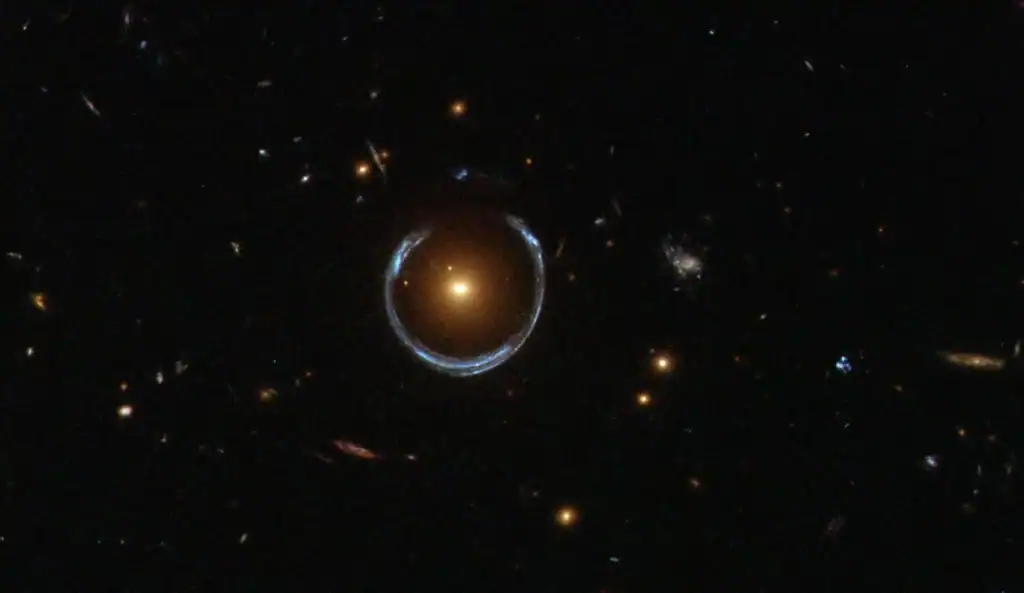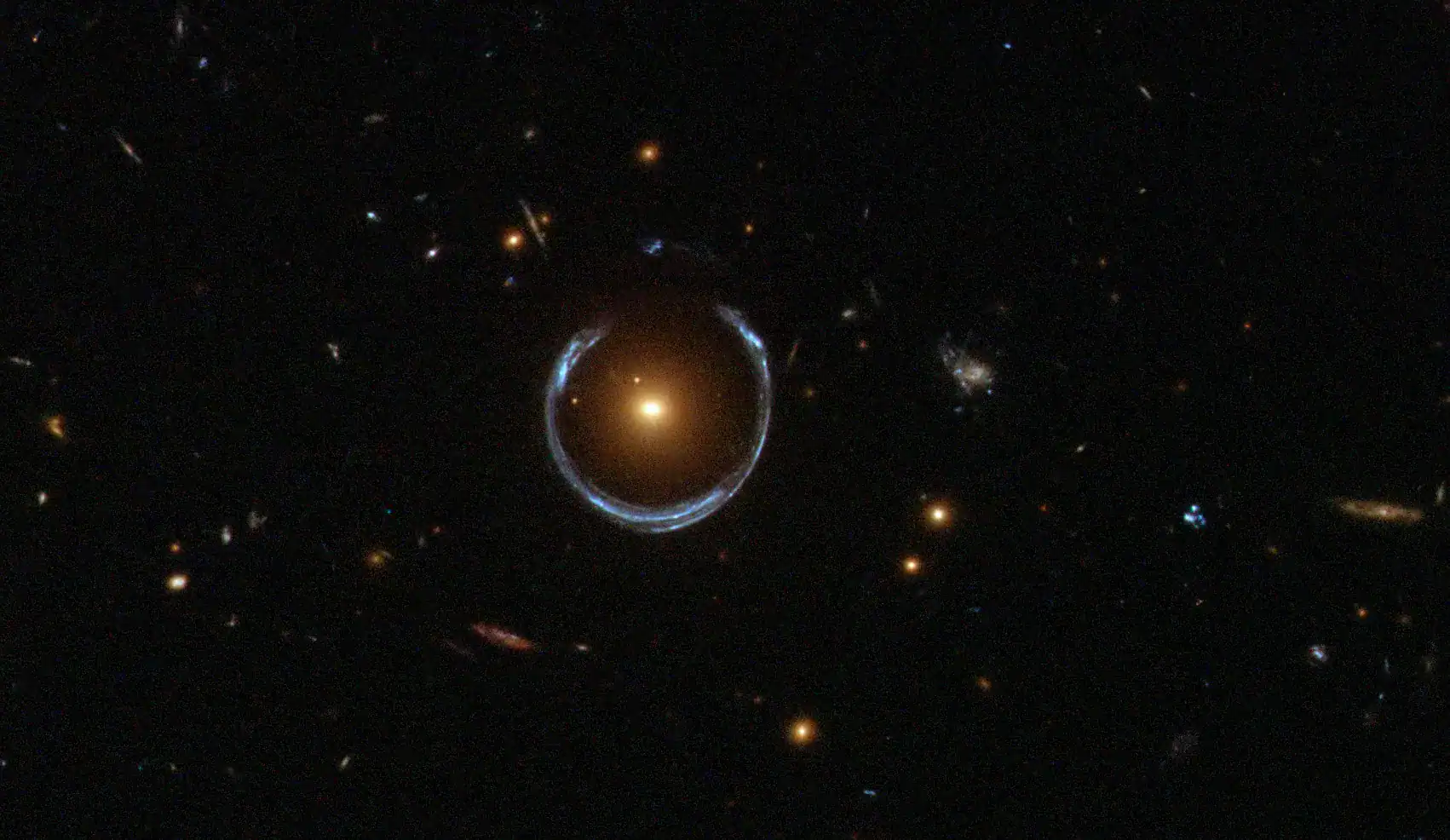 Astronomers first discovered the Cosmic Horseshoe in 2007 using data from the Sloan Digital Sky Survey. In this Hubble visible and infrared image, the blue horseshoe is a distant galaxy magnified and distorted by the strong gravitational pull of the massive foreground Luminous Red Galaxy. Called an Einstein Ring, this lensed galaxy required the exact alignment of the foreground and background galaxies, making this object’s nickname “the Cosmic Horseshoe” particularly apt.
Astronomers first discovered the Cosmic Horseshoe in 2007 using data from the Sloan Digital Sky Survey. In this Hubble visible and infrared image, the blue horseshoe is a distant galaxy magnified and distorted by the strong gravitational pull of the massive foreground Luminous Red Galaxy. Called an Einstein Ring, this lensed galaxy required the exact alignment of the foreground and background galaxies, making this object’s nickname “the Cosmic Horseshoe” particularly apt.
It sits in the heart of a galaxy so massive it bends light into the shape of a giant horseshoe. And within that galaxy lurks an even greater monster: a black hole 36 billion times the mass of our Sun.
Astronomers say the object inside the “Cosmic Horseshoe” galaxy may be the most massive black hole ever measured. Some five billion light-years away, this black hole is ten thousand times heavier than the one at the center of the Milky Way. As such, it sits close to the theoretical upper limit for black hole size. Scientists say they’ve detected it at high confidence — what astronomers call a 5-sigma result — by fusing two independent lines of evidence.
“This is amongst the top 10 most massive black holes ever discovered, and quite possibly the most massive,” said Professor Thomas Collett of the University of Portsmouth. “Most of the other black hole mass measurements are indirect and have quite large uncertainties, so we really don’t know for sure which is biggest. However, we’ve got much more certainty about the mass of this black hole thanks to our new method.”
A Different Way of Weighing the Unseen
As their observational kit improves, astronomers have claimed a handful of record-breaking black holes over the years. But the numbers often come with wide margins of error. Most of those candidates are active — blazing as quasars — so their masses are estimated indirectly, based on the energy released by material falling into them. Quasars are the brightest objects in the universe, powered by supermassive black holes actively consuming surrounding matter.
The Cosmic Horseshoe’s black hole is different. It is dormant, loitering at the galaxy’s core without feeding on nearby gas. This also means you can’t study it with conventional methods. Instead, researchers combined two powerful tools: gravitational lensing, in which the galaxy’s mass bends and magnifies light from more distant galaxies, and stellar kinematics, the measurement of how fast stars move around the black hole.
“It is altering the path that light takes as it travels past the black hole and it is causing the stars in the inner regions of its host galaxy to move extremely quickly — almost 400 kilometers per second,” said Collett. “By combining these two measurements we can be completely confident that the black hole is real.”
This dual approach, described in a study in Monthly Notices of the Royal Astronomical Society, yielded a precise estimate. They landed on a staggering 36.3 billion solar masses, with an uncertainty of about 6 billion.
A Galaxy at the End of Its Life
The Cosmic Horseshoe is already famous among astronomers for its dramatic Einstein ring — a near-complete loop of light from a background galaxy. That spectacle reveals the incredible heft of the foreground galaxy, hundreds of times the mass of the Milky Way.
The galaxy is what researchers call a “fossil group,” the end state of a galaxy system that has swallowed all its bright neighbors. “It is likely that all of the supermassive black holes that were originally in the companion galaxies have also now merged to form the ultramassive black hole that we have detected,” Collett said. “So we’re seeing the end state of galaxy formation and the end state of black hole formation.”
Across the cosmos, heavier galaxies tend to host heavier black holes, a pattern known as the M–σ relation. But the Cosmic Horseshoe’s black hole sits about one and a half standard deviations above that trend, adding to evidence that the most massive galaxies may grow their central black holes more quickly — or in different ways — than smaller ones.
What Comes Next
Lead author Carlos Melo, of the Universidade Federal do Rio Grande do Sul in Brazil, believes the method could reveal many more hidden giants. “What is particularly exciting is that this method allows us to detect and measure the mass of these hidden ultramassive black holes across the universe, even when they are completely silent,” he said.
The discovery happened almost by accident. The team was initially studying the Cosmic Horseshoe to map its dark matter, not to find a record-breaking black hole. Now, they plan to search systematically, using data from instruments like the European Space Agency’s new Euclid space telescope, to see how many such dormant giants are out there — and what they can tell us about how galaxies and black holes grow together.
For the Cosmic Horseshoe, the story may already be over: the galaxy has stopped making stars, and its central black hole has long since stopped feeding. But in measuring its immense mass, astronomers may have opened a new window into the hidden history of the universe’s most extreme objects.

